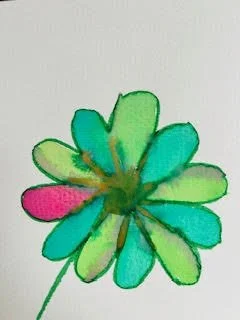Before I Can Study Contemplation Through Data Science: Rebuilding Embodied Infrastructure
I ran the Army Ten Miler in 2014. I was 37, about to start IVF. My doctors told me to stop running. I didn't realize this would be the first point of disconnection from my body.
Running hadn't always been my practice. Tennis stayed with me into college, and then I let it go. Running - something I never particularly liked or excelled at - became a replacement because of a college roommate. But it stuck and I carried it into graduate school and my professional life. It became how I knew my body, how I processed, and how I stayed grounded. And then in 2014, it stopped.
The Question That Surfaced
Earlier this week I gave a presentation in my data science class asking whether computational methods could capture contemplative transformation in teachers. I was drawing from McCaw's (2025) study of seven teachers whose meditation and yoga practices shaped their sense of purpose, presence, and understanding of self. Hegna and Ørbæk's (2024) review of 247 studies found a similar gap: research captures what teachers think and say, not the sensory, bodily, emotional dimensions teachers describe as mattering most.
But as I prepared that presentation, something else surfaced. To study the nuance of contemplative practice - the very nuance that's so hard to capture through any method - I realized I needed to return to practice itself. And in returning, I'm discovering I'm not just answering a research question. I'm filling a personal and professional gap simultaneously.
I'm trying to rebuild the embodied infrastructure that once supported me - that buoyed me through challenges, through the everyday, through breathing, thinking, being, knowing. I'm making a case for practices I need to fully embrace - not prescriptively, but in a self-study, self-knowing way that's right for me - so that I can help others find contemplative practices that are right for them.
What Disconnection Looked Like
From 2014 to 2021, I moved through institutional spaces with invisible networks and unspoken rules I couldn't figure out. In those darker networks, I found lights - people who showed up. I wasn't navigating alone.
Those years included teaching, developing research on teacher well-being, and building relationships with systems leaders, educators, and families. I was doing work I cared about. And I was prioritizing something that mattered deeply to me and my family - trying to have a baby. That's what humans do. We make choices about what matters most.
What disappeared gradually was the embodied infrastructure that kept me connected to my own strength. Running stopped when my doctors told me to stop. Tap and figure-skating had been dormant since childhood. Kayaking, which I'd loved at 14, got no dedicated time as adult life intensified.
I maintained my yogasana practice. After we moved to New York in 2018, I found the women's class at the Iyengar Yoga Institute of New York. The highly skilled instructors taught me to attend to my abdomen as fluid space (“an ocean”) while medical protocols asked me to monitor that space constantly. That practice held me through those years.
But one practice - even one practiced deeply - couldn't provide what multiple forms of embodied observation offer. Each practice attends differently to duration, precision, coordination, breath, physical capacity, and I needed that full range to stay grounded in my being and knowing.
Some people suggested talk therapy - that I should just talk and process verbally. But my body didn't need more words. I was already swimming (drowning?) in verbal processing - teaching, research, writing, explaining, defending, articulating. Academic culture demands verbal communication above all else. What my body needed was movement, not more language about the difficulty.
Without that fuller embodied infrastructure, the mind-body connection that had grounded my strength started to fray. I moved at institutional pace - fast, productive, reactive. But I couldn't stay grounded in what I knew and who I was because I'd lost the practices that maintained that connection.
What Well-Being Discourse Misses
Institutions talk about well-being, self-care, work-life balance, and mental health resources. But here's what that discourse misses: it's people who provide that support, not systems. It is the people who show up - family members, mentors, friends, teachers - that matter more than any well-being policy.
And well-being discourse often frames the individual as the problem to be fixed. As if maintaining embodied connection while navigating invisible institutional rules and undergoing fertility treatment is just a matter of better boundaries.
Here's what I'm learning: embodied inquiry isn't about self-optimization or productivity. It's methodological infrastructure that helps you observe what's actually happening - including when you're in systems whose rules you can't decode. When that infrastructure disappears because you're prioritizing something that matters more, you lose access to observational capacity. Not because you failed, but because you were human, making choices about what mattered most.
What Embodied Infrastructure Provides
Embodied inquiry maintains your capacity to:
Distinguish between what you're observing and what you're being told to see
Stay grounded in your knowing when systems demand compliance
Move at an observational pace rather than at a reactive pace
Trust what your body tells you about what is sustainable versus what is harmful
This is methodological infrastructure, it’s not a wellness practice. My first data science instructor emphasized that he takes time, that he steps back to think. That permission to slow down, to observe rather than immediately analyze - it requires the same infrastructure that embodied practices build.
What Comes Next
In my Lion's Roar article, I wrote about finding refuge in liminal space - reclaiming voice after systems failed. That piece released the pain. I've sat with it.
I'm ready to move through it and on from it. This readiness to move, this choice to rebuild - that's part of what I'm documenting here.
What follows is documentation of the crossing - the transition, the emergence from liminal space. The readiness, the commitment to practices as the way through - this is the self-study happening in real time. I'm investigating my own embodied knowing as I rebuild capacity, not after I've already rebuilt it.
In 2021, my daughter was born. Now it's 2025. She's four. I'm 47, pursuing a data science degree, running a consulting practice. Before this next phase intensifies, I'm choosing to rebuild what I lost.
I'm beginning to document what these practices teach about rebuilding the mind-body connection that grounds observational capacity. I don't know where this investigation will lead. Each practice may reveal something different. This is phenomenological investigation through movement - wondering what returns, what remains dormant, what shifts as infrastructure rebuilds.
This marks a shift in my writing: from advocacy for contemplative practices in teacher preparation to self-study of my own embodied knowing. Questions about what can be captured through research methods - computational or otherwise - become inseparable from questions about what I need to rebuild in myself. I'm wondering what might emerge from this embodied foundation.
Why Embodied Infrastructure Matters
Embodied practices maintain the mind-body connection that keeps you grounded in your strength - your capacity to observe, to know, to navigate from steadiness. When medical protocols, institutional pace, and motherhood pull you away from those practices, you lose access to it.
I lost that connection across a decade. Now I'm rebuilding that infrastructure deliberately. Not as self-care, but as the methodological foundation that allows contemplative observation. And as the personal foundation that allows me to navigate from strength.
Embodied inquiry isn't optional. It's the infrastructure that keeps us connected to our capacity to observe what's actually happening - in research and in life.
References
Gupta, S. S. (2025). The myna bird knows her name. Lion’s Roar: Bodhi Leaves. https://www.lionsroar.com/the-myna-bird-knows-her-name/
Hegna, H. M. & Ørbæk, T. (2024). Traces of embodied teaching and learning: a review of empirical studies in higher education. Teaching in Higher Education, 29(2), 420-441. https://doi.org/10.1080/13562517.2021.1989582
McCaw, C. T. (2025). Contemplative practices and teacher professional becoming. Educational Review, 77(2), 446-474. https://doi.org/10.1080/00131911.2023.2215467
Sarika S. Gupta, Ph.D., is the founder of Ecological Learning Partners LLC.


